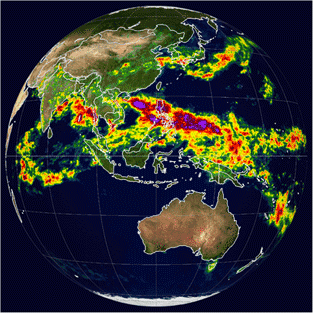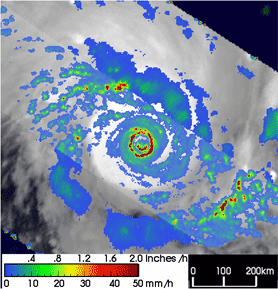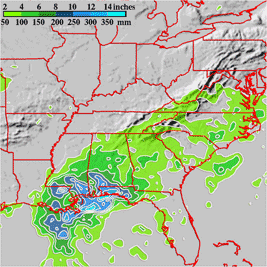Why Measure Rainfall from Space?
The comprehensive measurement of precipitation is valuable for a wide range of research areas and related applications with practical benefits for society. However, precipitation is difficult to measure because precipitation systems tend to be somewhat random in character and also evolve very rapidly.
 Within a single storm, it is not uncommon for precipitation amounts to vary widely over a very small area. Also, in any given area, the amount of precipitation can vary significantly over a short time span. In the summertime, for instance, a single thunderstorm lasting just 20 minutes will produce 2 inches of rain over a city, but leave the adjacent town just 10 miles away unscathed. During the winter, heavy snows downwind of the U.S. Great Lakes often accumulate to several feet, but along a narrow corridor only a few tens of miles wide.
Within a single storm, it is not uncommon for precipitation amounts to vary widely over a very small area. Also, in any given area, the amount of precipitation can vary significantly over a short time span. In the summertime, for instance, a single thunderstorm lasting just 20 minutes will produce 2 inches of rain over a city, but leave the adjacent town just 10 miles away unscathed. During the winter, heavy snows downwind of the U.S. Great Lakes often accumulate to several feet, but along a narrow corridor only a few tens of miles wide.
All of these factors make precipitation difficult to quantify. Reliable ground-based precipitation measurements are difficult to obtain over regional and global scales because most of the world is covered by water and many countries are not equipped with precision rain measuring sensors (i.e., rain gauges and/or radars). It might be possible to study precipitation over a small area using ground-based data, but rarely beyond that. The only practical way to obtain useful regional and global scale precipitation measurements is from the vantage point of a space-based remote sensing instrument.
 |
 | |
All images above show the Earth's rainfall measurements taken from NASA's TRMM satellite.
|
|










